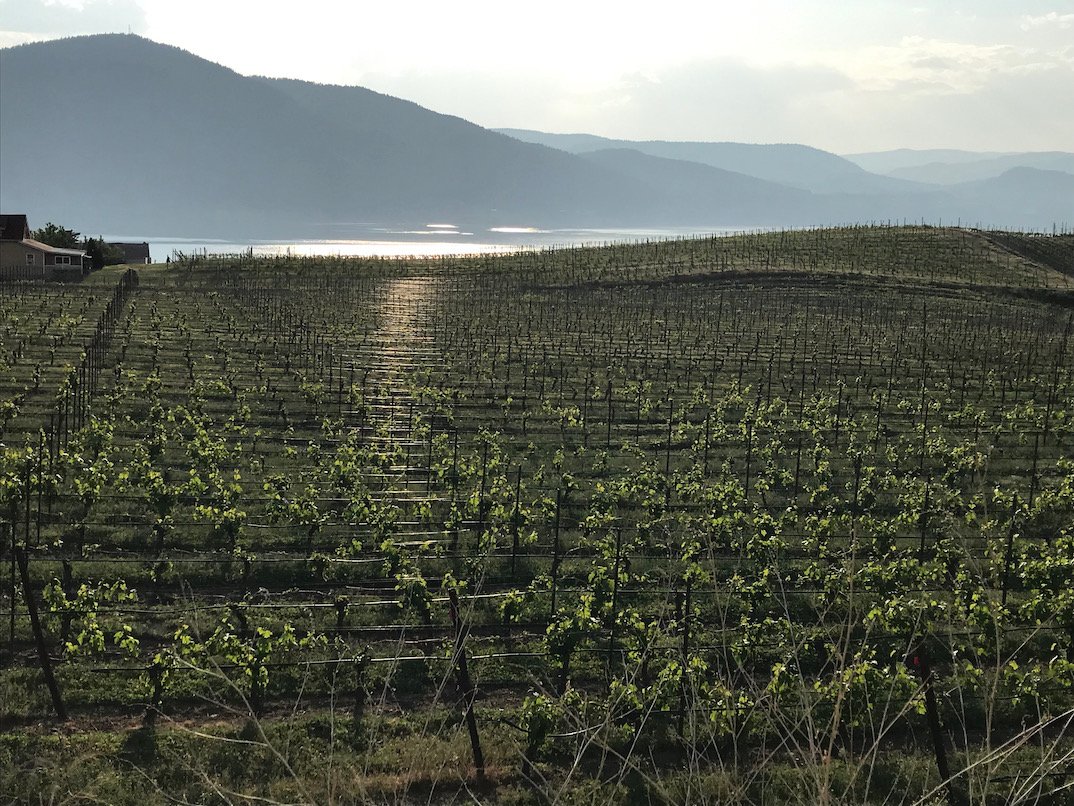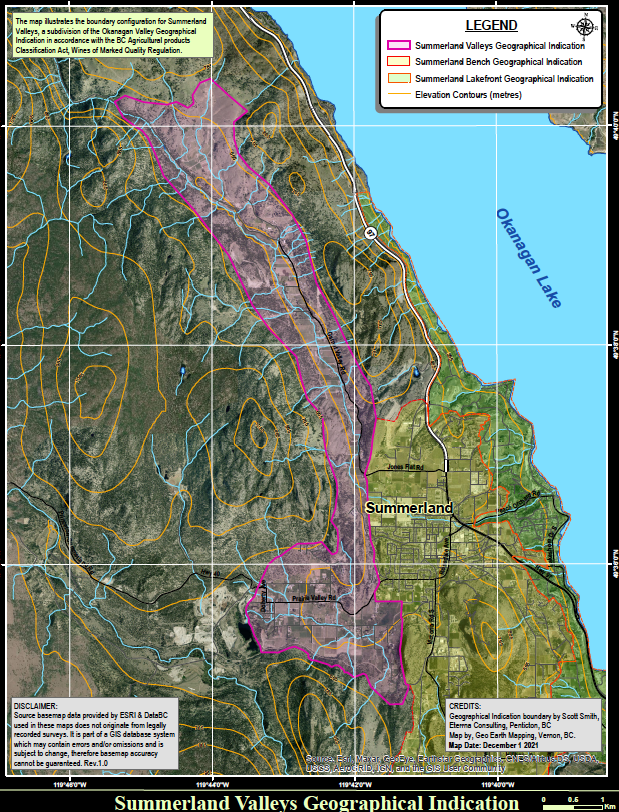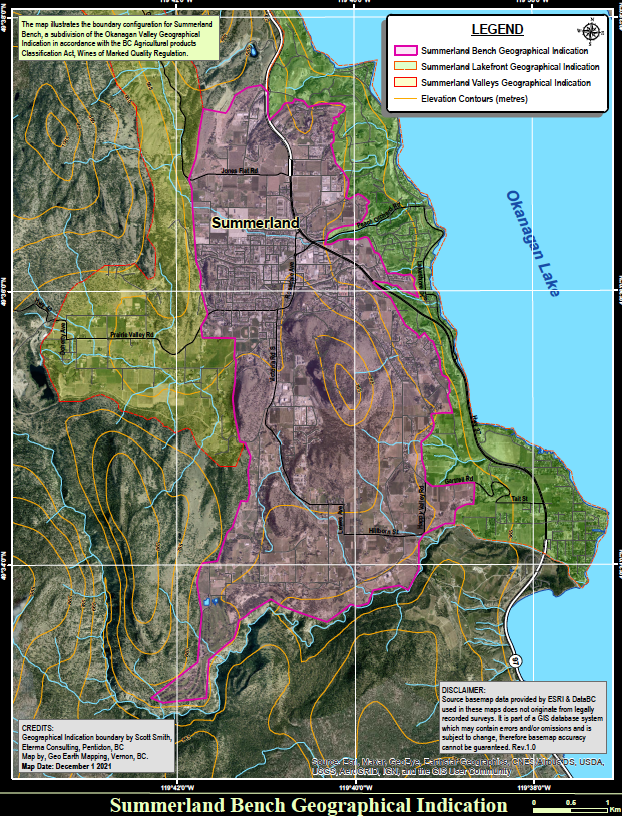New Contours on British Columbia’s Wine Appellation Map

On June 28, 2022, British Columbia’s Ministry of Agriculture, Food and Fisheries announced a major step forward for the Okanagan Valley’s wine industry. Six new sub-appellations were approved (the official B.C. term is sub-Geographic Indication or sub-GI), bringing into focus several viticultural areas making up the middle to northern range of grape growing and winemaking in the Okanagan Valley.
This is to be celebrated.
But the project remains incomplete: the new sub-GIs highlight the need for a robust supporting regulatory and scientific architecture to bolster the credibility of the emerging sub-GI scheme in British Columbia’s wine regions.
Existing Okanagan Valley sub-GIs Source: Wine Growers BC
The benefits of B.C.’s emerging sub-GI system
The new sub-GIs further delineate the generic wine map of the Okanagan Valley GI (within which all the above sub-GIs reside). At 175 km/100 miles long, with roughly 3,800 hectares/9,600 acres of vineyards planted along myriad lakes, geological features and soil types, grape growers, winemakers and BC wine lovers already know that “the Okanagan” is not particularly helpful anymore to signal the characteristics or origin of the wines.
As many of the proponent groups assert in their Proposals to the B.C. Wine Authority (BCWA), a defined sub-GI gives additional meaning to consumers, and adds to the process of developing specific identities based on “terroir” - geologic history, soil types, defining landmarks, micro- or meso-climate conditions and recognition of certain varietals well-suited to the location. (These are among the technical eligibility criteria as presented in the Proposals and Technical Reports on the BCWA’s website.
The question is whether the establishment of sub-GIs at this stage of evolution of the industry is meant to reflect established characteristics of vineyards and wines, or to shape the future development of those characteristics. I suggest the recent sub-GI approvals are more the latter than the former.
The technical reports submitted with the applications to the BCWA define in detail the land features, the geologic and soil history and the natural processes over time that generate soils that are amenable to grape growing and that lend specific qualities to the wines. For example, in the East Kelowna Slopes sub-GI, “soils formed on hummocky glaciofluvial parent materials have gravelly subsoils with surface cover of sandy or loamy sand of various thickness” (East Kelowna Slopes Technical Report), while in the Summerland Valleys sub-GI, “[soils] have formed from a variety of parent materials: wind-blown fine sands overlying glacial till, gravelly and/or sandy glaciofluvial deposits, silty glaciolacustrine deposits, recent stream deposits and the decomposed organic materials” (Summerland Valleys Technical Report) .
The technical reports refer to grape varietals that have generally been successful in those delineated areas. However, several of the reports note the absence of weather stations providing lengthy historical temperature data, or detailed evidence of specific micro- or meso-climate characteristics. Now that this tranche of sub-GIs is in place, wineries and growers should continue to monitor and measure conditions to further bolster the assertion of a specific identity of the sub-GI.
The proponent wineries of the new sub-GIs are very pleased with the approval of their regions. The three representatives I spoke with are all planning to use the new designation on their labels and in their marketing.
As Darryl Brooker, President of Okanagan Crush Pad Winery noted, the approval of the three Summerland sub-GIs (Valleys, Bench and Lakefront, each of which hosts OCP vineyards), as well as the others in the Okanagan Valley, are a needed step for the evolution of the overall region. The application process was industry-led, which ensured wide support, and now that it is in place, it will build meaning with consumers. Furthermore, he noted that the sub-GI designation is most useful for the vineyard-specific and estate wines in OCP’s portfolio – in other words, those which best tell the story of Summerland’s three sub-GIs.
Bill Knutson, owner of SpearHead Winery in the new East Kelowna Slopes sub-GI, concurs that the value of the new sub-GI will become more significant over time, as consumers come to have a sense of the characteristics of the wines from that place.
Contours of East Kelowna Slopes Sub-GI from Technical Report.
Stephanie Stanley, Winemaker at Peak Cellars in the new Lake Country sub-GI, notes that both Peak Cellars and sister winery O’Rourke Family Estate plan to include “Lake Country” on all of their labels, indicating origin of their entire production on the east slope of Okanagan Lake between Kelowna and Vernon. And she has observed the unique characteristics emerging in the vineyards in Lake Country over several years:
Contours of Lake Country Sub-GI.
“This helps give our wines a sense of place. Knowing where the grapes are grown (site, slope, aspect, proximity to lake, soil types, etc) can help tell the story about a wine’s potential character before even tasting the wine. What we have noticed over the years is a beautiful balance between flavour development and ripening during harvest; flavours are ripe and rich before sugar accumulation gets too high, and the big shift between daytime and nighttime temperatures allows for natural acidity retention and lower pHs. The result is wines with wonderful flavour, vibrancy, brilliant balance and ever so slightly lower alcohols.”
Stephanie Stanley, Winemaker, Peak Cellars
The opportunity
The somewhat aspirational nature of the announcement of B.C.’s new sub-GIs implies that to attract and retain consumers’ attention – and that of the professional wine community, including sommeliers, wine buyers and wine critics both locally and around the world – grape growers and wineries within all sub-GIs have an obligation to work toward fulfilling the typicity and unique characteristics ascribed by their new designation.
The promise of the unique identity granted by a sub-GI has myriad benefits, but these will take time to achieve. The connection to the consumer is a complex relationship, built over vintages on several related factors including the typicity, style and quality of the wine(s); the cachet and “cool factor” of a sought-after region (which in turn is built on awards, reviews, the support of retailers and restaurants, and word-of-mouth); and more generally on the evolving sense of a BC wine culture… and (since we are Canadian!) the approval and attention of the rest of the wine world.
All of this should translate to a reliable customer base, strong international reputation for wine quality and wine culture, and all-important sales. While there is no direct evidence (yet) that being in a B.C. sub-GI can strengthen a winery’s balance sheet* a reputation boost – based on viticultural and winemaking practices and marketing to bring attention to wine quality and typicity – can bring a value boost, and should underpin the health of more wineries. Today, many operate in a very high-cost setting, and over time, the recognition from being in a sub-GI should underpin wineries’ premiumisation strategies.
* Paul Rickett’s VARketing! database tracks over time myriad statistics around volume and price by varietal and sub-GI, among many other variables. This resource could be used to give an industry-wide indication over time of the change (presumably increase!) in selling price of a bottle from a prestigious sub-GI.
The long term economic benefit
For much of BC’s (and the entire “new world”) wine industry, it has looked to Europe – led by France and Italy – as the world’s definitive approaches to establishing legally protected unique viticultural regions.
Based on longitudinal economic research conducted by the European Commission (as I reviewed in this post in 2020), recognised European appellations and GIs can bring value premiums for the wineries within them. In the example of France, its top GIs catapult it to a value premium rate of 4.13. This indicates by how much the value is elevated for wines produced in a given GI-protected region compared to wines that are not GI-protected.
Essentially, the VPR represents the potential monetisation of reputation and influence that GI schemes bring over time to the wines produced within them.
The study further found that the export channel was by far the most lucrative: sales value of GI-protected wine from the EU to the rest of the world increased by 70% between 2010 and 2017, compared to 33% within the EU.
While B.C.’s nascent sub-GI system has a long way to go to achieve European-level value premiums (likely a two decade+ project), the industry as a whole should develop a strategy that pursues opportunities to define, educate and promote the wines from B.C.’s GIs and sub GIs. The payoff, as I note in my 2020 post, can be measured by a significant increase in the prices commanded for GI wines:
“A significant lesson from the European Union data: the value premium derived from GI-protected regions can drive a very significant boost in price for the wines. B.C.’s marketing strategy and Canada’s export strategy should be designed to increasingly emphasise GI-protected wines as they come into their own over the years, to maximise the available premium.”
With maturity comes responsibility…
Part of the maturation process of the B.C. wine industry is the evolution of its governance and regulatory structures.
The six applications for sub-GI recognition announced in June were submitted within the first half of 2021. A review was conducted by the BC Wine Authority and conveyed to the Minister of Agriculture, Food and Fisheries for approval, which was granted 12 to 18 months later. While the BC Wines of Marked Quality Regulation directs the BC Wine Authority to keep and make publicly available the maps delineating B.C.s GIs and sub-GIs, it does not set out publicly available criteria for evaluating a sub-GI proposal, nor does it clearly set out the BCWA’s role in receiving, evaluating or recommending a sub-GI proposal for approval.
By comparison, in the same week as the Okanagan’s new sub-GIs were approved, the Oregon Wine Board and Willamette Valley Wineries Association announced Oregon’s newest AVA, the Mount Pisgah, Polk County AVA, the 11th nested AVA within the Willamette Valley. The approval process by the federal Alcohol and Tobacco Tax and Trade Bureau (TTB) took five years, and the notice in the Federal Register of the new AVA ran to five pages (of 3 columns each). The TTB publishes application guidelines in its regulation, where criteria are transparent and clearly set out. Oregon Wine Board President Tom Danowski stated: “These federal AVA designations take years to achieve as the standards are rigorous for establishing a region as clearly differentiated.”
The B.C. wine industry and its claims must be able to stand up to external scrutiny. In this regard, a regulatory To-Do list for B.C.’s emerging GI system would incorporate several improvements:
· Amend the Wines of Marked Quality Regulation to set out the specific authority and mandate of the BCWA regarding sub-GI applications.
· Publish (either in regulation or by the BCWA) the criteria and process for applying for a new sub-GI. A Handbook for applicants would also be helpful.
· As part of the criteria, set out minimum requirements for the various indicators (e.g. historical data over a period of “x” years for Growing Degree Days (GDD) and temperature at various sites within the proposed sub-GI). This should be developed within the industry, overseen by the BCWA.
· BCWA should publish on its website not only the final Proposal and Technical Report, but its own evaluation and reasons for recommendation of approval of the sub-GI, together with any evaluation and comment by the Ministry of Agriculture.
Equally essential to B.C.’s architecture of its GI system are the governance and administrative functions after a GI and sub-GIs are established. The absence of this today can lead to questions – particularly and legitimately by wine critics and professionals elsewhere in the wine world - about the standards themselves (have proponents met or exceeded the bar?) ongoing compliance (which could fall under the BCWA’s authority to regulate VQA labelling, but a perceived gap exists for non-VQA 100% BC wines), and about evidence of progress toward achieving the typicity and unique characteristics claimed by existing and new sub-GIs.
This To-Do list should include:
· BCWA should be given formal authority and resources to oversee and administer not only the VQA system but also the GI and sub-GI framework.
· BCWA (enabled/supported by entities such as the Summerland Research & Development Centre, academic bodies and consultants) should be a repository of industry-generated relevant sub-GI information over the coming years, such as refining temperature (e.g. Growing Degree Day (GDD) and Frost Free Period (FFP)) data, as well as refined data about soil types within and across sub-GIs.
· A repository of descriptive data about wine characteristics should also be developed – potentially based on findings of VQA tasting panels – providing evidence over time of the unique chemistry, aromatic and taste profiles of various varietals in a given sub-GI.
If the world’s spotlight is to shine on the high quality wines of the Okanagan Valley and B.C.’s other wine regions, these should be able to stand up to scrutiny of the claims made on the label and in promotional material about the specificity and uniqueness in the bottle.
The future is bright, but there is still work to do. The competition from established and other rising wine regions around the world is fierce. B.C. wine has a tremendous opportunity to enhance value and reputation through continuing to refine the contours of its wine map, and to execute a GI-led promotion and export strategy. The industry will need to bring its “A” game, and prepare to play the long game.
If you wish to receive all WineDrops posts, please join the mailing list here: https://winedrops.ca/contact.








